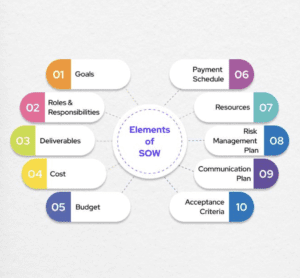A Step-by-Step Guide to Writing an SOW for Any Project and Industry
Writing a scope of work (SOW) is one of the most important steps in any project. It is a document that outlines the project’s objectives, deliverables, timeline and budget. It also helps ensure that all stakeholders involved in the project understand the expectations and responsibilities of their roles. In this blog, we will explore what a scope of work is, its benefits, elements, and how to create a scope of work for any project and industry.
Author

Share

What is a Scope of work?
A scope of work (SOW) is a written document that outlines the expectations, deliverables, timeline, and budget for a specific project. It is a critical document for any project and is used to ensure that all stakeholders have a clear understanding of the project’s objectives and the responsibilities of each involved. A scope of work can also help to identify any potential issues or risks associated with the project.
Why Is Scope of Work Important?
Using an SOW can provide many benefits to any project. It can help to avoid misunderstandings by clearly outlining the project’s goals, timeline, and budget. This can help to ensure that all stakeholders are on the same page and can help to prevent any conflicts or disagreements throughout the project. An SOW can also help to set expectations for all involved, as it outlines the deliverables, resources, and tasks that need to be completed. Additionally, it can help to prevent scope creep by detailing the specific tasks and deliverables that need to be completed during the project.
Another benefit of an SOW is that it can help to identify potential risks associated with the project. This can help to ensure that any issues can be addressed before they become serious problems. Additionally, an SOW can help to ensure that the project stays on track and is completed on time and within budget.
Elements of a scope of work
The scope of work typically includes the following elements:
1. Goals: A clear statement of the objectives and desired outcomes of the project.
2. Roles and Responsibilities: Detailed descriptions of the roles and responsibilities of all parties involved in the project.
3. Deliverables: A list of the products and services to be delivered, including specific milestones and timelines.
4. Cost: The estimated cost of the project, including labour, materials, and other expenses.
5. Budget: A detailed breakdown of the financial resources required to complete the project.
6. Payment Schedule: The timeline and payment terms for payment of services.
7. Resources: This outlines the resources that will be needed to complete the project.
8. Risk Management Plan: A plan for evaluating and managing any potential risks associated with the project.
9. Communication Plan: A detailed plan for how the project team will stay in contact with each other and provide feedback.
10. Acceptance Criteria: A set of criteria that must be met in order for the project to be considered complete.
How to create a scope of work
1. Identify the Project: Before you begin creating a Scope of Work (SOW), you need to clearly define the project. What needs to be done? Who is the customer? What is the timeline? What is the budget? What are the deliverables?
2. Outline the Objectives: Once you have a clear understanding of the project, you need to clearly define the objectives. What are the goals of the project? What is expected to be accomplished? What are the deliverables?
3. Define the Tasks: Based on the objectives, you can begin to define the tasks that need to be completed. What needs to be done? How long will each task take? Who is responsible for each task?
4. Set the Timeline: Based on the tasks, you can set a timeline for the project. This should include start dates, end dates, and milestones along the way.
5. Establish the Budget: Establishing a budget for the project is important for both parties. This should include the cost of materials, labour, and any other cost associated with the project.
6. Set Payment Terms: You should also establish payment terms for the project. This should include the payment amount, the payment date, and any other terms related to payment.
7. Review and Finalise: Once all of the information is gathered, you should review the SOW and make any necessary changes. Once the SOW is finalised, both parties should sign and date the document.
8. List the roles and responsibilities: Specify who is responsible for what tasks, and how they will work together.
9. Document the scope of work: Create a formal document that outlines the scope of work and includes all of the information listed above.
Tips on writing an effective scope of work
Since your scope of work document is so important, it’s only logical that it should be written with care. In order to get the most out of your scope of work, keep the following tips and best practices in mind when you’re getting started.
Be specific
Because your scope of work document is so important, it stands to reason that it should be written with care. When you’re getting started, keep the following tips and best practises in mind to get the most out of your scope of work.
Similarly, it is critical to be specific when discussing other important details such as project deliverables, project schedule, and budgetary & financial details.
Keep it Realistic
After you’ve determined all of the tasks, milestones, and deliverables for your project, you’ll need to provide an initial budget and project schedule. It is critical to be realistic and avoid making any false promises when doing so. It can be tempting to exaggerate or commit to getting things done as quickly as possible, but you’ll gain a lot more credibility and do a better job if you set a realistic timeframe and budget.
When estimating your schedule and budget, it’s also a good idea to consult with colleagues and other project team members to ensure that everything is feasible.
Communicate openly
Communication is a key element of putting together a great scope of work.
First, you should meet and communicate openly with all the most important people on your project team before submitting your scope of work. This will ensure that everyone has signed off on its contents and will be able to deliver what they’ve committed to.
Get free consultation
Turn your website into a lead generation machine using our strategies.
Get industry updates
in your inbox.
Sign up for our monthly newsletter.
Get free consultation to increase your business
We will understand your business and brainstorm some ideas to tackle your problem.
You might be intersted in reading
Top 10 Web Design Trends to Watch for in 2023
Web Design trends are continuously evolving, adapting to new technologies, user behaviours and cultural shits. In 2023 there are several exciting web design..
Boost Your Business: The Power of Combining Website Design and Branding
As the online marketplace becomes increasingly competitive, having a website is no longer enough to stand out. To create a successful online presence, businesses must also focus on creating a strong brand identity. In this blog post, we’ll explore how website design and branding work together to help businesses achieve their goals.
Maximising the Benefits of Your Website with a Web Strategy
A web strategy is a plan that describes the measures a company should take to attain its online goals and objectives. It is a road map that guides the development and implementation of a company’s digital presence, which includes its website, social media, and other online platforms.
Top 10 Web Design Trends to Watch for in 2023
Web Design trends are continuously evolving, adapting to new technologies, user behaviours and cultural shits. In 2023 there are several exciting web design..
Boost Your Business: The Power of Combining Website Design and Branding
As the online marketplace becomes increasingly competitive, having a website is no longer enough to stand out. To create a successful online presence, businesses must also focus on creating a strong brand identity. In this blog post, we’ll explore how website design and branding work together to help businesses achieve their goals.




